Some results from our Tesla Magnifying Transmitter tests
Time to give you folks a glimpse of what I have been up to these months. :)
I think we have been successful. Perhaps a little bit too much so because it looks as if Maxwell is incomplete and Einstein is wrong. Not that I think that that would be incorrect, but it would just be so much easier for modern scientists to accept these results without these conflicts.
Our goal was to prove that a discharge at a sufficiently high potential attracts extra charge from the atmosphere. This would explain how lightning strikes can be many kilometres long and explain their stepwise formation.
It is our hypothesis that Tesla wanted to mimic natural lightning to attract atmospheric electricity and make it available for us to use.
In the following tests only one HV transformer was used reducing the primary voltage from 44 KV to 22 KV.
The tests results differ depending on whether or not there is thunder in the air. I suspect that the potentials in our set-up are normally too low to produce the effect that we are looking for but the vicinity of thunder clouds may lower the threshold, so that even with 0.8-1.2 MV we do get the results aimed for.
In this report I am mostly using the results of ‘D010-4ms’ (day 10, oscilloscope set to 4 ms). The oscilloscope takes 20 million samples for each channel during a 80 ms interval. The pulses are numbered using a 4 digit number. This number can be calculated by dividing the sample number where the pulse starts by 10,000 and ignore everything behind the decimal point. Thus pulse 0191 starts between sample 1,910,000 en 1,920,000. The 40 million samples retrieved in each test are analysed using a desktop computer.
During this test (natural) thunder could be heard, but the rain started about 15 minutes after the test was completed.
Here we see part of the samples as shown on the oscilloscope. The first 12.5% and the last 20% are outside of this display. Every 10 ms the spark gap fires 2 or 3 times. The yellow traces show the current from ground to the secondary coil (Ls), the blue traces show the current in the return circuit (see diagram).
Here you see how the pulses have been numbered. The vertical axis at the centre is at sample 10,000,000. The vertical grid lines are at a distance of 1 million samples or 4 ms. The vertical scale is set to 5V but it represents a value that is linearly dependent on the current in the measurement units.
The first 7 pulses with a vertical scale in amps.
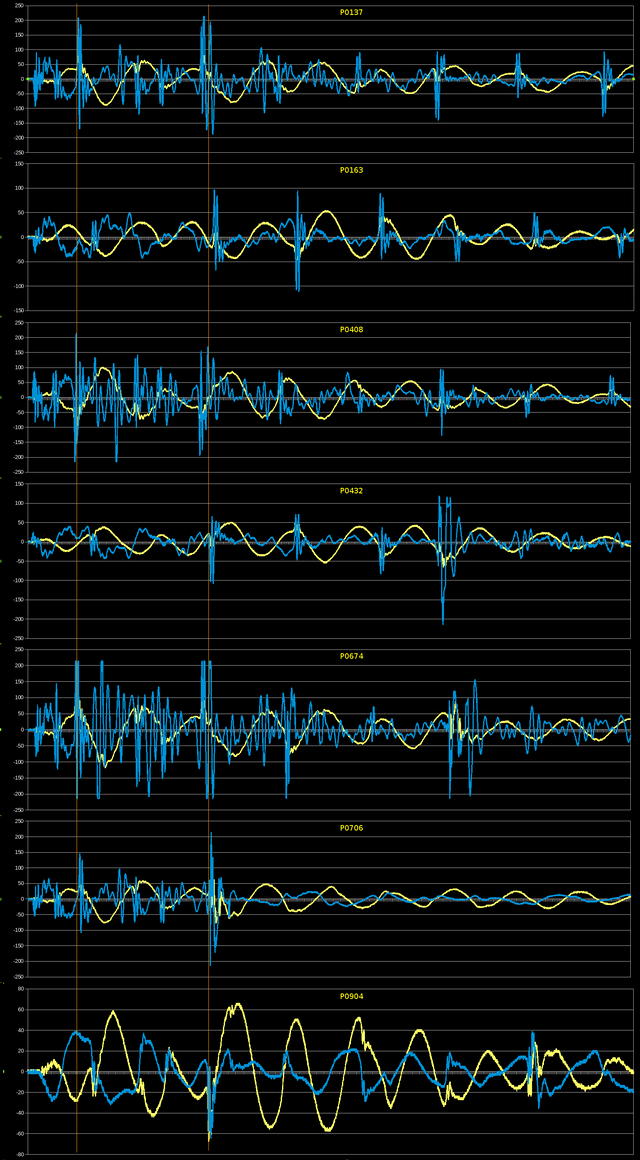
The first 7 pulses with a vertical scale in volts (calculated from charge and capacitance). Because the extra coil is in ½λ-resonance and we use the coils capacitance calculated for ¼λ-resonance the actual capacitance is probably smaller and thus the voltage higher. I estimate the actual values to be about 1.5 times higher.
Now we zoom in on pulses 0706 and 0904 because they are close together and the first does show the effect that we would like to see while the latter does not. It appears as if this effect occurs within a small fast moving region. It reminds me of a plasma globe where the starting points of the streamers move across the inner globe’s surface.
Pulse 0706 with “lightning effect” as seen on the oscilloscope.
This “lightning effect” manifests in two ways that are clearly visible:
1 – the amplitude of the blue signal is much greater than that of the yellow signal
2 – the blue trace shows a high frequency (3.6 MHz) component that roughly matches the resonance frequency calculated using the capacitance (260pF) of the roof and the induction (7.6 μH) of its ground connection.
When there is no discharge between the coil and the roof, then electrostatic induction is the only (known) cause for a current in the return circuit. For example; a high (+) potential in the Tesla coil will attract (-) charge in the roof and the other way around.
The blue (return) trace shows a current well before the yellow trace moves. This means there is current flowing to/from the roof before any charge could have passed through the Tesla coil, and thus before there can be a high potential there.
The distance from the spark-gap and capacitors to the roof is almost 6 meter, the wire from the roof to the ground is again 6 m, so the minimum distance signals need to travel to the measurement unit is 12 m. Light can do so in about 40 ns (10 pixels in the above image).
The return trace first shows a very high frequency signal that changes to about 4 MHz, the resonance frequency of the return circuit.
Next, near the zero crossings of the yellow signal we see violent moves. When the current is at its lowest the voltage is at its maximum, so we can assume this is the result of a discharge. In these discharges we consequently notice a higher amplitude in the blue trace than in the yellow. Also we notice that the traces move in synch up and down.
With very high voltage discharges we see a high frequency noise appear.
When there is not enough energy left for new discharges, the oscillations slowly fade in the frequency of the Tesla coil.
Below we show calculated values in Amp, Volt (Q/C) and Joule (CV2/2).
Much can be said about the method of calculation but it should be seen as a rough indication.
Pulse 0904 without “lightning effect”, fragment 1

Again the blue trace responds stronger in the beginning than the yellow trace, but in the frequency of the Tesla coil.
Discharges are completely in synch.
The discharge frequency lowers to about that of the Tesla coil, but...
the first impulse in every discharge is in alternating direction. This would indicate about half that frequency.
Detail pulse 0904, 2nd fragment
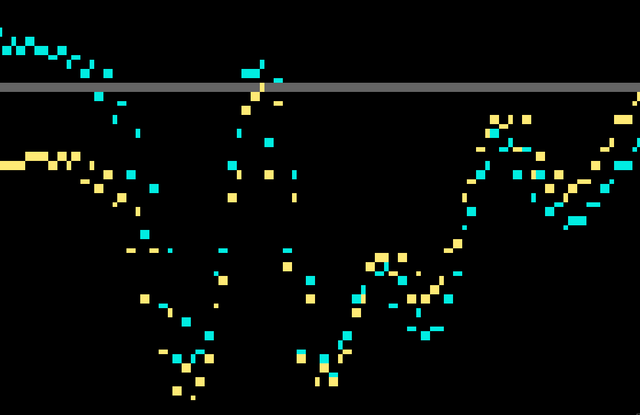
Zooming in there seems to be no delay between the blue and the yellow trace. One pixel stands for 4 ns. The distance from the discharge to the yellow measurement unit is about 540 meters (wire length in the coils) and to the blue unit it is about 8 meter. Assuming the speed of light there should be a delay of (540-8)/300000000 s = 1.77 μs. This is clearly not the case.
The amplitude of both signals is identical which shows that the handmade measurement units work as intended.
However when lightning is near this changes dramatically:
Detail pulse 0706, 1st and 2nd fragment
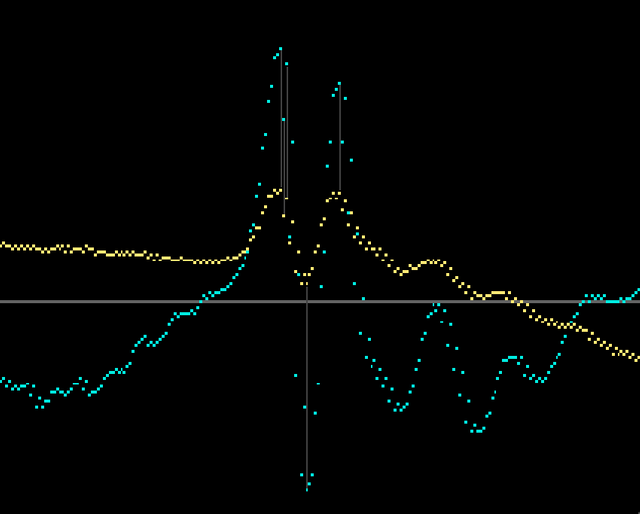
We notice that the amplitude of the blue signal is more than 2x as big as that of the yellow signal. This matches our hypothesis that atmospheric charge has been added.
To make the comparison complete, the calculated values in Ampère, Volt and Joule:
This “lightning effect” occurs in connected intervals and more frequently when lightning is near.
Where the blue signal is bigger than the yellow, this effect is present.
Without lightning around, the graphs look much more as one would expect based on modern accepted theories.
The blue trace follows the yellow trace.
The only peculiarity is that the blue trace starts out stronger than the yellow trace and there is no delay between the traces.
More to come...

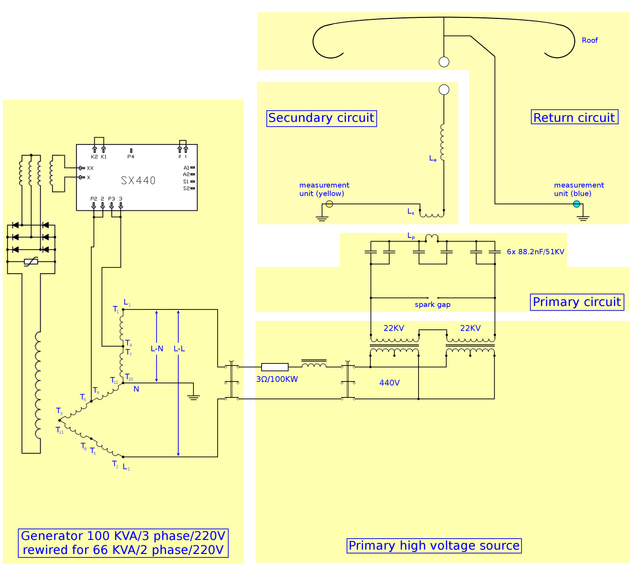
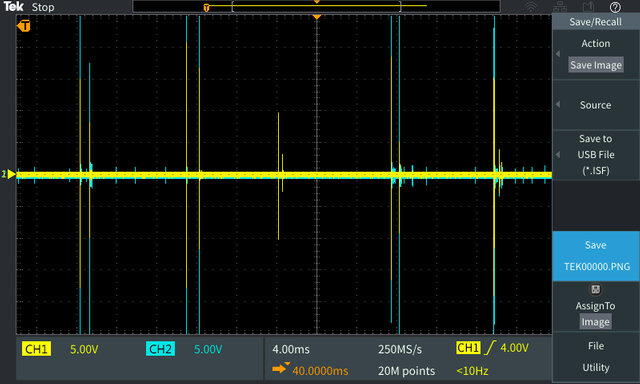
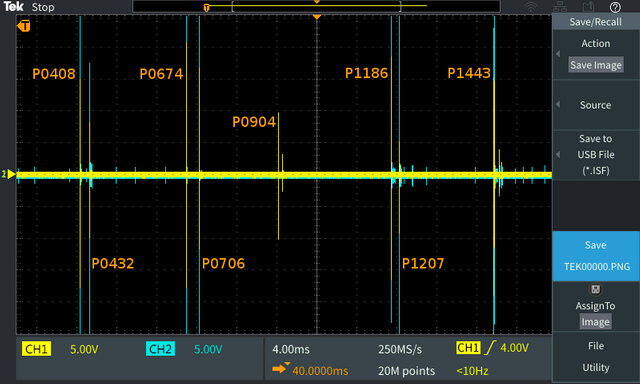
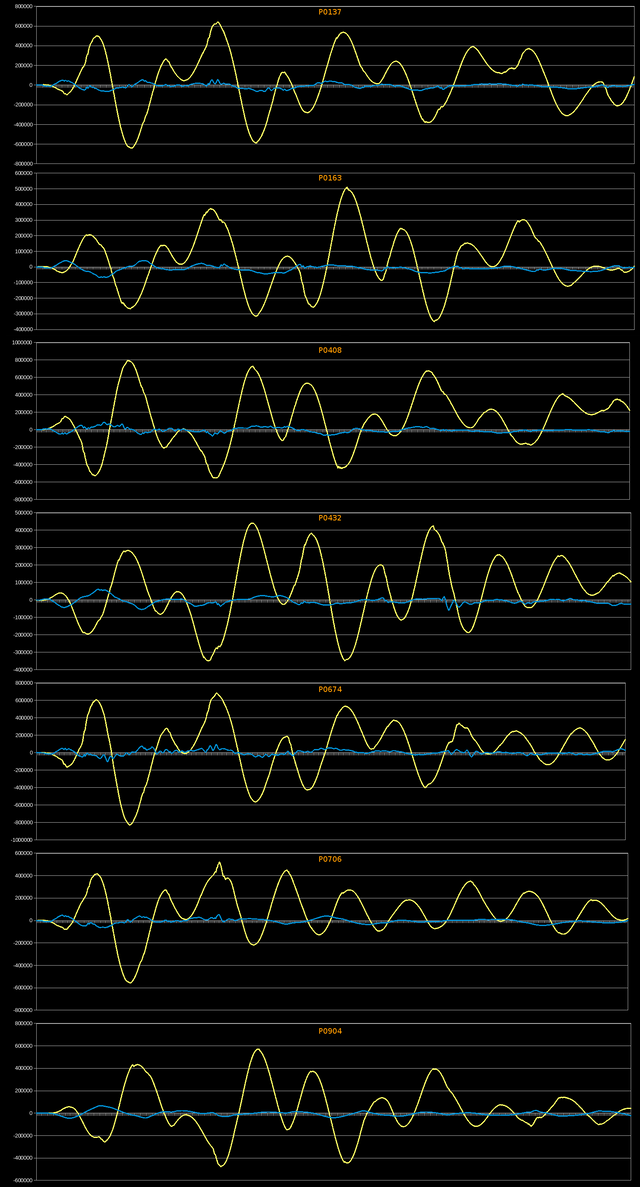
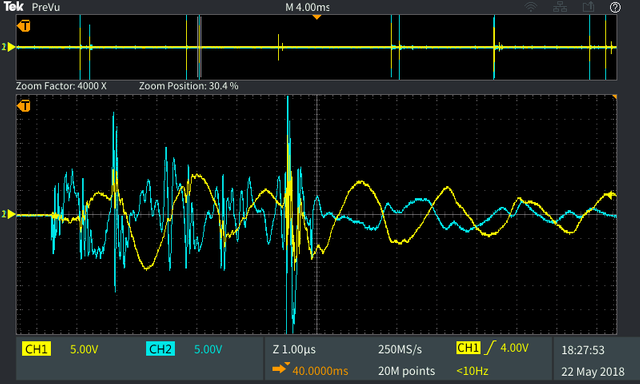




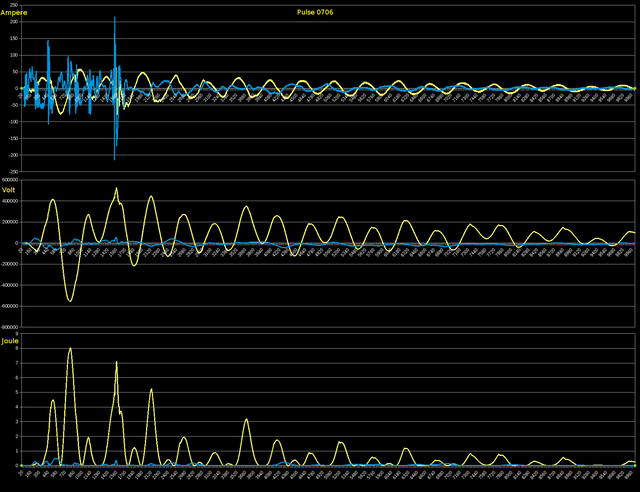



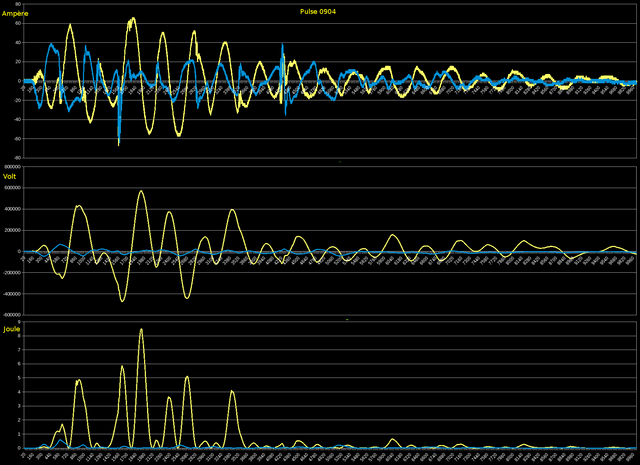

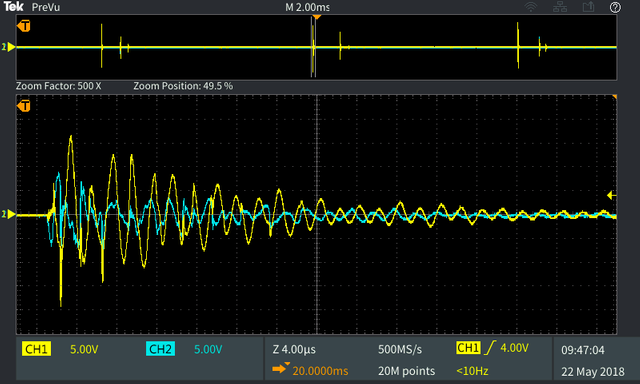

Thank you for sharing this work! This confirms a lot of what I have studied regarding the Wardenclyffe Tower. I do have a few questions if you can answer....
Does the excited secondary circuit need to be a harmonic of the return circuit? Some of his drawings show the legs of the return circuit as coils offering more induction before the ground connection...
Since you are using a spark gap, you are primarily using damped wave oscillation, correct? Have you used a continuous wave (CW) to excite any systems you've made?
I ask because I built a small - 250 watt - CW 50khz TMT system and would like to replicate these experiments if possible. CW oscillation usually comes with lower power inputs and lower voltage outputs....My system is CW and I think im going to try building a return circuit and receiving systems on the same frequency as the return circuit and measure received power. I can also build a HV damped wave driver if needed. Thanks for any insights!
In the CSN you will read that Tesla tested with the return circuit being tuned to the same frequency as the secondary and extra coil. In other separate notes you will read that the return circuit can be any frequency.
To achieve CW you will most likely resort to transistors. Transistors put a limit on you primary circuit voltage and consequently on the output voltage as you already noted. The voltage required for this system to work is much higher than what can readily be achieved with transistors.
I also suspect that the abruptness of a spark gap plays a role and there is really no transistor that comes anywhere near what a spark gap does in that respect.
I have built a transistor driven 50W TMT, more or less as you describe it and did not get any interesting results.
Thanks for the feedback! I built the CW system to test out power magnification. I was also going to use the CW as a carrier signal and possibly integrate logic into the signal going on/off to make a binary communication system between Tx and Rx.
The above experiments are very interesting, I will likely test this schematic with my CW setup and see if there are differences in power in primary, secondary and return circuits with adjustments to size of torroid and height of torroid in return circuit.
Thanks again!
Just a quick note that I have seen this...
I shall come back later to read carefully and absorb!
Thank You!
:D
😄😇😄

There are new posts that you may be interested in. ;)
Lots more to take in.... :)
Thanks for letting me know! :D
Will check it out soon... ;)
Wow! Wow!
Hello @mage00000 if you have a bitshares account you are entitled to a 100,000 Ventureo funding to support your project:
https://ventureo.frama.wiki/
OK, now I have a bitshares account (same name: mage00000)
Made with your referral link.
Fine, you just received 100 000 Ventureo. You can add your organization on the Ventureo wiki http://ventureo.frama.wiki/ make a page for your organization and explain to other members what you are offering to the community.
I tried to add a new page to do as you requested, but it seems to get stuck somewhere. It does not do anything after I click "create this page".
Can you perhaps create the page so that I can enter its content?
There is a bug on the edit button, you have to use the dokuwiki editor button (the second one !)
Ok, done.
So now, you are welcome to write a post about Ventureo to attract more participants !
I'd love to write a post about it, but what do I write?
I would have to know something about ventureo and what it can do for me first. How does it help me and my project? Why would other people be interested? Where can I learn more about it? What is the idea behind it?
Sounds good. But I don't have a bitshares account. I will talk to my partners tomorrow.
Oh wow that's pretty awesome! Do you think it's achievable in a safe manner?
I.e. strapping contraptions to roofs of homes to draw in electricity and not fry everyone around?
FREE energy is the best part though
I think that is possible with a slightly adjusted and modernized method.